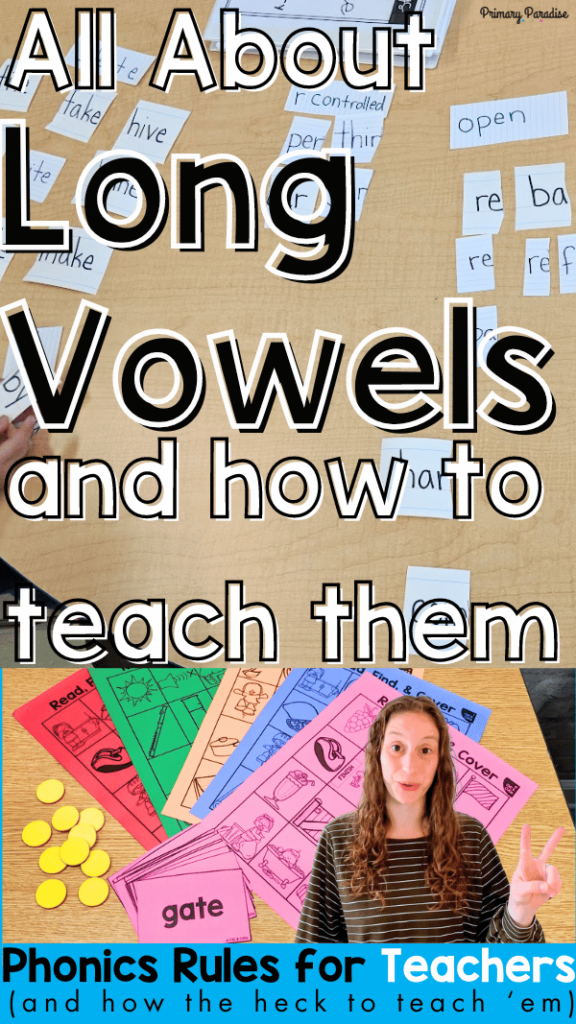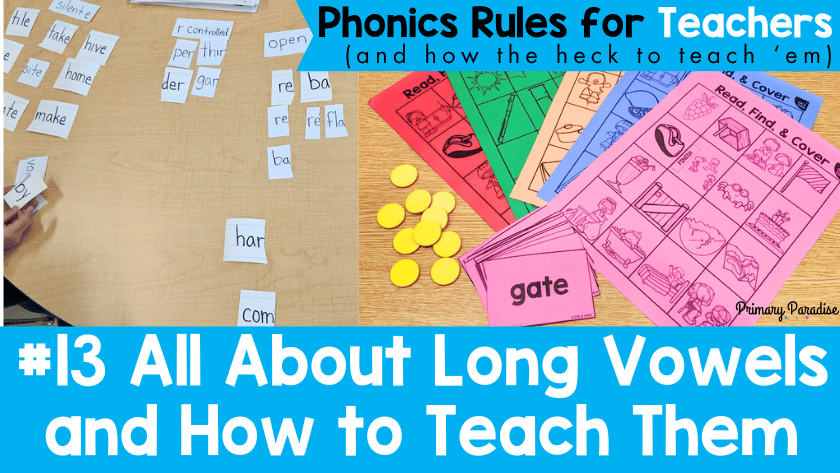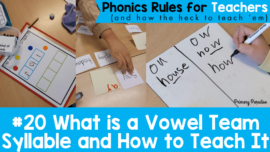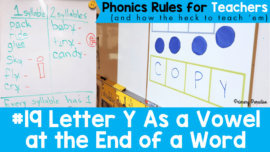What is a long vowel? When should you teach your students about long vowels? And what order should you teach long vowel spelling patterns? Let’s learn all about long vowels, why they’re important, and how to teach them to your students.
This is post 13 in my series Phonics Rules for Teachers (and How the Heck to Teach ‘Em). If you’d like to see previous posts, you can click here.
Would you rather listen or watch? Find a podcast version of this blog post or watch the video below.
What is a long vowel?
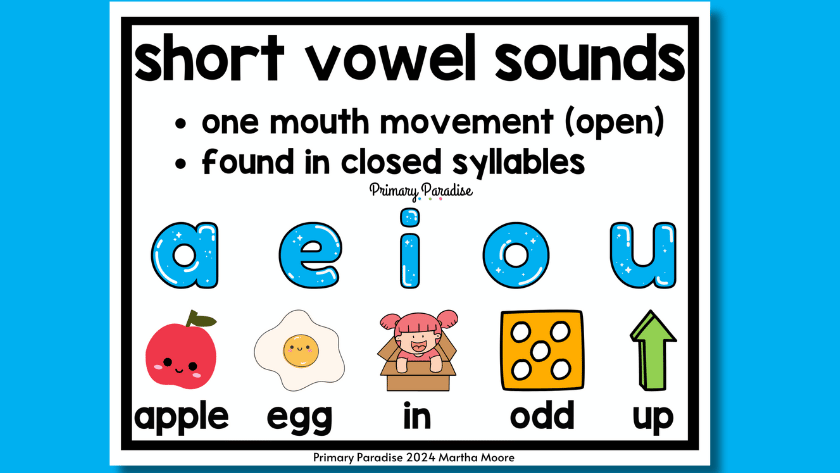
If you remember, a short vowel is called a short vowel because our mouths only make one movement when we make a short vowel sound.
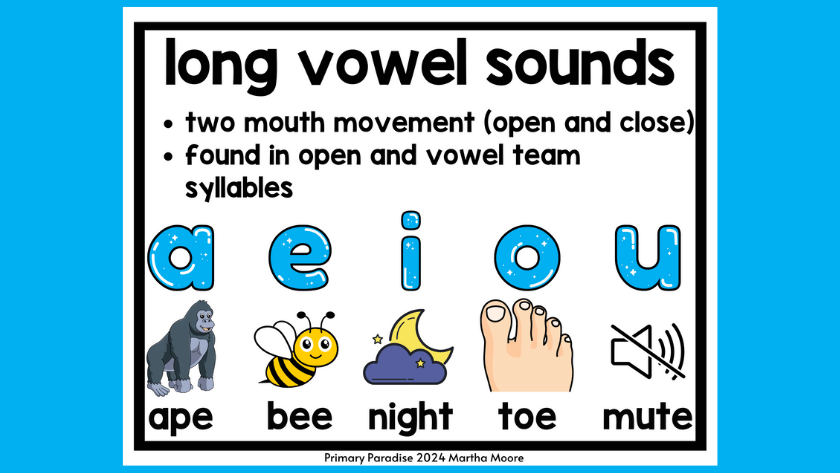
Long vowels are similarly called long vowels because our mouths make two movements when we make a long vowel sound. They open and then close. The sounds of long a, e, and i all end with a y sound at the end and o and u both end with a bit of a w sound. Technically long vowels can also be classified as diphthongs because they glide through two sounds.
The 5 long vowel sounds can be heard in these words: ape, eat, ice, no, use.
What should students understand before you teach long vowels?
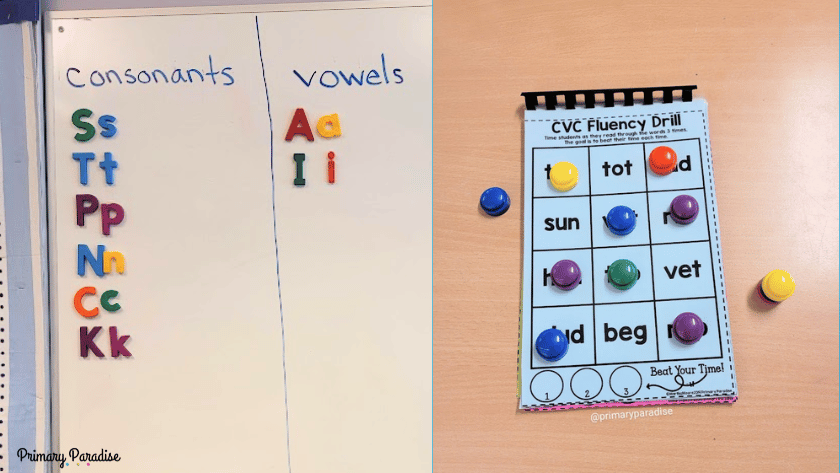
Before you begin to teach long vowel sounds, students should understand the following concepts:
- That letters represent (or spell) sounds
- Single letter sounds
- Short vowel sounds (they should have a solid understanding)
- To read words that contain short vowels and single letter sounds
I also like to teach consonant digraphs before long vowels, but you could teach long vowels first.
How can we spell long vowel sounds?
Long vowel sounds can be spelled a variety of ways. In addition, some spelling patterns can represent both a long vowel sound and another vowel sound. There are 5 vowel sounds which can be spelled 32 different ways.
| long a | long e | long i | long o | long u |
| a – baby a-e – cake ai – main ay – pay ei- rein ea- steak eigh- eigh ey – they | e – be e-e – these ee – see ea – meat ie – piece y – baby ei – receipt ey – key | i – hi i-e – hike igh – night y – by y-e – type ie – tie | o – so o-e – cone oa- boat ow- snow oe – toe | u – unite u-e – use ew – few ue – fuel eu – feud |
What order should we teach long vowel spelling patterns?
If you’re looking at allllll of the different long vowel spelling patterns and feeling overwhelmed, you don’t need to. Students can not (and should not) learn all of the spelling patterns for long vowels at once.
Instead, you can teach them in a structured, organized way starting with the easiest and most common sounds and moving towards the more complicated and least common sounds. So, rest assured that your kindergarteners don’t need to know that eu and ue both can spell long u.
While different curricula teach long vowel sounds in different orders, there is no one perfect scope and sequence. Here is the order I like to teach long vowel spelling patterns.
- open syllables
- silent e syllables
- most common vowel team syllables
- y as a vowel
- less common vowel team syllables
In future posts, I’ll share specifically how you can introduce each type of long vowels.
How to Introduce Long Vowel Sounds
In my next post, I’ll begin to share specifically how I teach each type of long vowel spelling pattern. Here are some simple and effective strategies for introducing long vowel sounds.
- Review short vowel sounds– Before teaching long vowels, students need to have a solid understanding of short vowel sounds. Once they do, you can introduce long vowel sounds. First, write a, e, i, o, and u on the board and as students which sound each letter represents. Then, say some words with short vowel sounds, and have students identify which short vowel sound their hearing orally. You can also point to the letter that spells that sound. For example, if you say pin, they say /i/, and you or a student could point to the letter i.
- Review vowel sounds- Then, take a moment to specifically review what makes a vowel sound a vowel sound. A vowel sound is produced with an open, unblocked mouth.
- Review that letters can represent (or spell) multiple sounds- Next, remind students that letters represent sounds and that some letters can represent multiple sounds.
- Listen for long vowel sounds orally- Then, tell students that they are going to learn new vowel sounds. Again, remind them that vowel sounds are produced with an open mouth. You can illustrate this by having them say the /b/ sound and then the /a/ sound and ask them to point out which is the vowel sound.
- Produce long vowel sounds orally-Next, tell students you’re going to say a word slowly, and ask them to repeat it and then see if they can identify the vowel sound. In this activity they are only focusing on hearing and producing the sound orally. Say ape slowly. Ask them which two sounds they here- /ā/ and /p/. Have them identify which is the vowel sound- /ā/. You can repeat this with a word for each long vowel sound (examples- eat, hi, no, use).
- Review the sounds from each word- After you’ve gone through each long vowel sound, have students say each sound again- /ā/, /ē/, /ī/, /ō/, /ū/. You can explain that these vowel sounds are called long vowel sounds because our mouth makes two movements- we open and close our mouth.
Now your students have a beginning foundation for understanding long vowel sounds. All of this work can begin orally, but we can quickly move into teaching long vowel sounds in connection with specific spelling patterns. I like to begin orally so students remember that long vowel sounds are just that sounds and they are not connected to just one spelling patterns. From here you can then begin to teach students open syllables in connection with long vowel sounds. I’ll share how to do that in our next post.
